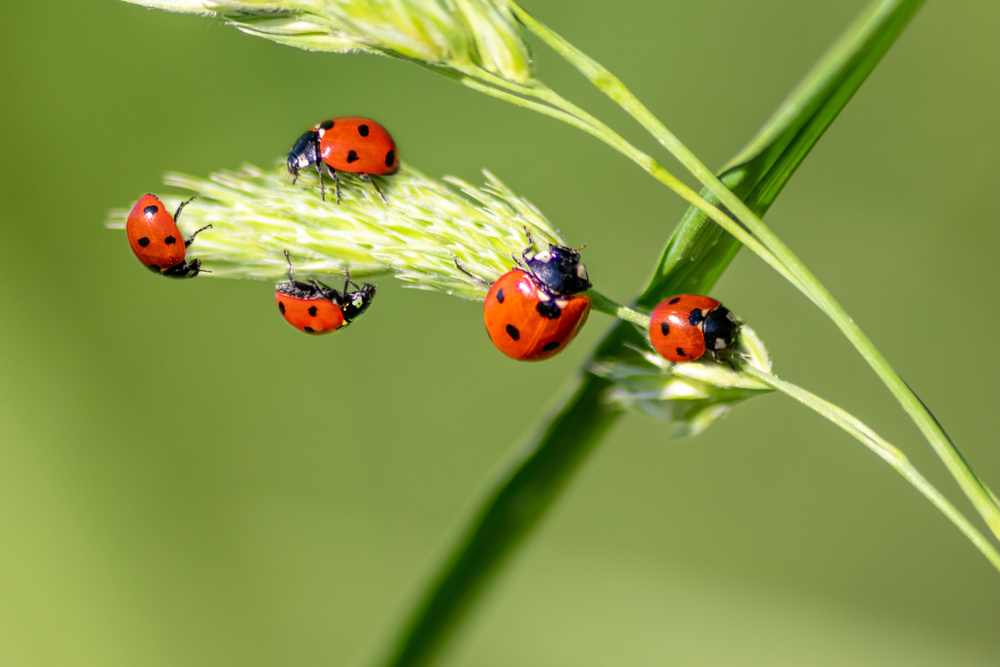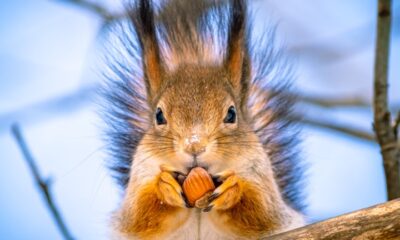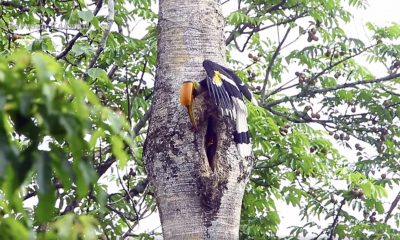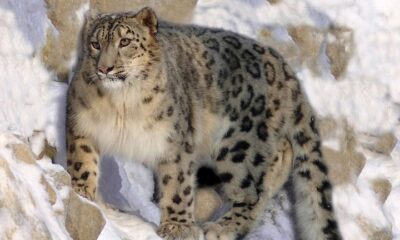ANIMALS
Lovely Ladybugs: 26 Fascinating Facts About The Cutest Bugs
Published
3 months agoon

Shutterstock
Ladybugs probably hold the title for the cutest bug. There is no way you wouldn’t be able to spot a ladybug sunbathing on a leaf. With over 5,000 species worldwide, these beetles are beneficial to gardeners and farmers for their ability to control pests. Their unique appearance and life cycle make them an interesting bug to observe. Whether as a symbol of good luck or a natural pest controller, ladybugs are valuable members of the insect world.
Ladybugs are beetles

Shutterstock
Ladybugs belong to the order Coleoptera, which encompasses all beetles. Their structure, including hardened forewings, aligns with typical beetle anatomy. The term “ladybird beetle” is often used interchangeably. Despite their name, they are neither true bugs nor exclusive to females.
They belong to the family Coccinellidae

Shutterstock
The scientific family Coccinellidae encompasses ladybugs across the globe. This family is a diverse group, including thousands of species with varying appearances and habits. The defining characteristics include their rounded bodies and bright coloration. Many species are considered beneficial due to their predatory behavior.
There are over 5,000 species of ladybugs

Shutterstock
Ladybugs are incredibly diverse, with thousands of species identified so far. Each species varies in size, color, and behavior. While many are beneficial, some species can be harmful to plants. New species are still being discovered, especially in remote areas.
Ladybugs are found on every continent except Antarctica

Shutterstock
Ladybugs are widely distributed across diverse ecosystems. They can adapt to various climates, from tropical to temperate regions. However, extreme cold in Antarctica makes it inhospitable for their survival. Their ability to thrive globally showcases their resilience.
They are commonly red with black spots

Shutterstock
The classic ladybug appearance features a red shell with black spots. This pattern serves a dual purpose: aesthetic appeal and predator deterrence. The spots and colors signal potential danger to predators, acting as a form of aposematism. However, the number and arrangement of spots can vary significantly among species.
Some species are yellow, orange, or black

Shutterstock
While red with black spots is iconic, many ladybugs sport other colors. Shades of yellow, orange, and even black are common in some species. These color variations can still serve a protective purpose, warning predators of their toxicity. The diversity in appearance highlights the adaptive nature of ladybugs across environments.
Ladybugs are predatory insects

Shutterstock
Ladybugs are natural predators, primarily targeting soft-bodied insects. Their diet helps control pest populations in gardens and farms. Aphids, a common prey, are especially susceptible to ladybug predation. This behavior has earned ladybugs their reputation as beneficial insects.
They primarily feed on aphids

Shutterstock
Aphids are the mainstay of a ladybug’s diet. These small pests are a significant problem for many plants. By consuming aphids, ladybugs help reduce the need for chemical pest control. A single ladybug can eat dozens of aphids daily, showcasing its efficiency as a natural pest controller.
They have a hard, dome-shaped exoskeleton

Shutterstock
The hard, rounded exoskeleton of a ladybug provides crucial protection. This structure shields them from physical harm and predators. The dome shape also helps them roll off surfaces when disturbed. Their exoskeleton is brightly colored, further enhancing their defense mechanisms.
Ladybugs can secrete a foul-smelling fluid

Shutterstock
When threatened, ladybugs can release a yellowish fluid from their legs. This substance has a strong, unpleasant smell designed to deter predators. The secretion also contains chemical compounds that can be toxic to certain animals. This defensive behavior increases their survival chances in the wild.
Their bright colors act as a warning to predators

Shutterstock
The vivid coloration of ladybugs is not just for show. It serves as a warning to potential predators about their toxicity or unpalatability. This type of warning coloration, called aposematism, is effective against birds and other insectivores. Predators often associate bright colors with danger, avoiding ladybugs as prey.
They are beneficial to gardeners

Shutterstock
Gardeners value ladybugs for their role in pest control. By feeding on aphids, scale insects, and mites, ladybugs protect plants from damage. Their presence reduces the need for harmful chemical pesticides. A healthy population of ladybugs can significantly improve garden productivity and sustainability.
Ladybugs can hibernate during winter

Shutterstock
When temperatures drop, ladybugs enter a state of hibernation called diapause. During this period, they gather in large groups for warmth and protection. They often seek shelter in crevices, tree bark, or even inside homes. This adaptation allows them to survive harsh winter conditions and re-emerge in spring.
They lay their eggs on plants

Shutterstock
Ladybugs deposit their eggs on the underside of leaves, near aphid colonies. This placement ensures that the hatching larvae have an immediate food source. A single female can lay hundreds of eggs in her lifetime. The strategic location of eggs increases the chances of larval survival and growth.
A single ladybug can consume thousands of aphids in its lifetime

Shutterstock
Ladybugs are voracious predators, especially when it comes to aphids. Over the course of its life, a single ladybug can consume thousands of these pests. This behavior makes them invaluable for controlling agricultural and garden pest populations. Their appetite for aphids underscores their role as natural pest controllers.
Ladybugs have two sets of wings

Shutterstock
A ladybug’s wings are divided into two sets: the elytra and the membranous wings underneath. The elytra are hardened forewings that protect the delicate inner wings. When a ladybug flies, the elytra lift to allow the membranous wings to unfold. This dual-wing system provides both protection and efficient flight.
Their front wings are called elytra

Shutterstock
The elytra are the outer, hardened wings that give ladybugs their distinctive appearance. These wings are not used for flying but serve as a protective shield for the delicate flight wings. The bright colors and spots of the elytra play a crucial role in deterring predators. They also help reduce water loss in arid environments.
Ladybugs go through complete metamorphosis

Shutterstock
Like all beetles, ladybugs undergo a complete metamorphosis with four distinct stages: egg, larva, pupa, and adult. Each stage is critical for their development and survival. The larval stage is especially important for feeding and growth. This life cycle ensures that ladybugs are well-adapted for survival in various conditions.
Their life cycle includes egg, larva, pupa, and adult stages

Shutterstock
A ladybug’s life cycle begins with eggs laid on plants, often near food sources. The eggs hatch into larvae, which are active feeders and grow rapidly. After feeding and growing, the larvae transform into pupae, during which they undergo metamorphosis. Finally, they emerge as fully formed adult ladybugs, ready to repeat the cycle.
Some species of ladybugs migrate

Shutterstock
Certain ladybug species migrate to find suitable conditions for survival. They may move to warmer areas or locations with abundant food sources. Migration often involves large groups traveling together for safety. This behavior is crucial for species living in regions with harsh seasonal changes.
Ladybugs are often considered symbols of good luck

Shutterstock
In many cultures, ladybugs are associated with good fortune and prosperity. Their harmless nature and bright appearance contribute to their positive symbolism. Seeing a ladybug is often considered a sign of impending happiness or success. This belief has been passed down through generations worldwide.
They can live up to a year in the wild

Shutterstock
The lifespan of a ladybug can vary, but many species live for up to a year in the wild. Their life expectancy depends on factors such as food availability, climate, and predation. Ladybugs that hibernate during winter often live longer due to reduced metabolic activity. Their resilience and ability to adapt help them survive in diverse environments.
Ladybugs have been introduced to control pests in agriculture

Shutterstock
Ladybugs are often introduced to agricultural fields to naturally control pest populations. Their ability to consume large quantities of aphids and other pests makes them an effective biological control agent. This practice reduces the need for chemical pesticides, benefiting both crops and the environment. Introducing ladybugs has become a common method for sustainable farming.
They can play dead to avoid predators

Shutterstock
When threatened, ladybugs may fall onto their backs and play dead. This tactic confuses predators, giving the ladybug a chance to escape. By remaining motionless and lifeless, they reduce the likelihood of being eaten. This behavior is a form of defense that increases their survival in risky environments.
Ladybugs communicate using pheromones

Shutterstock
Ladybugs release pheromones to communicate with each other. These chemical signals help ladybugs find mates, detect food sources, and warn of danger. Pheromones play a key role in their social interactions, particularly in finding a suitable location for egg-laying. This form of communication is vital for maintaining population stability and ensuring reproductive success.
Not all ladybugs are beneficial; some are crop pests

Shutterstock
While most ladybugs are beneficial, some species can be harmful to crops. Certain types of ladybugs feed on plants rather than pests, causing damage to crops. These less-known species are often mistaken for helpful ladybugs due to their similar appearance. It’s important to identify the right species to ensure that ladybugs are working as natural pest control agents.
Conclusion

Shutterstock
Ladybugs are cute, but their beauty is not just skin deep. These insects play a pretty important role in the world of bugs. Their natural pest control abilities make them invaluable allies in both gardens and agricultural settings. Unfortunately, some ladybug species are endangered, but by appreciating these tiny creatures, we can help ensure their survival.
More Amazing Animals+
-


We Promise This Animal Is Not As Annoying As You…
-


26 Animals That Have The Cutest Babies
-


A Woman Recieves a Surprise Gift in the Air After…
-


The most beautiful thing you will watch today. Great #Hornbill…
-


20 Amazing Facts About Alpacas and Llamas
-


25 Reasons Why Huskies Make The Best Pets
-


Employee wrangles snake out of Disney World’s Magic Kingdom
-


27 Most Intelligent Animals And How They Problem Solve
-


Timothys up early for his morning spa appointment!
-


Why Lionesses Are the True Rulers of the Animal Kingdom
-


30 Toughest Animals That Will Do Anything To Survive
-


25 Fascinating Great White Shark Facts
